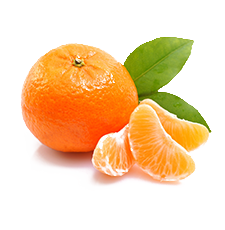Mandarin
(Tangerine)

Like that of other species the precise origin of the mandarin is far from certain but is believed to be either north-east India or south-west China. The earliest reference to this fruit dates back to the 12th centurt BC.
It was a further 400 years before mandarin distribution on a global scale began when two mandarin varieties from Guangzhow (Canton) were imported into England in 1805. From this introduction trees were sent to Malta, then to nearby Italy; it is believed the Mediterranean mandarin evolved ender cultivation in Italy shortly thereafter.
| MANDARIN | ||||||||
| Size | 1xxx | 1xx | 1X | 1 | 2 | 3 | 4 | 5 |
| Diameter (mm) | 78-86 | 72-78 | 68-72 | 64-68 | 59-64 | 55-59 | 51-55 | 48-51 |
| Count 10 KG | 45 | 54 | 60 | 66 | 72 | 84 | 96 | 108 |
| Count 15 KG | 75 | 90 | 100 | 110 | 120 | 140 | 160 | 180 |
It is the sister variety of Okitsu and derived from the Miyagawa variety in 1940 and registered in 1963.
Miho trees, like Okitsu, have a better growth habit and are more vigorous compared with Miyagawa. It is as productive as Owari and has slightly smaller fruit size. It tends to be flatter.
Miho matures earlier than Okitsu despite having lower acidity and higher sugar levels due to its being slower to color. As a result it is the preferred variety for exports.
Okitsu is a popular variety of Satsuma. It is a nucellar seedling from controlled pollination of Miyagawa in 1940 and is the sister of Miho, entering commercial production in 1963.
The tree have good vigor, producing fruit of similar size to Miyagawa but slightly flatter. Its flavor is also an improvement due to lower acidity and a slightly higher sugar level. Okitsu matures early and has good storage characteristics.
It was introduced to Europe in 1980 where it has become the leading early season Satsuma. Okitsu is also by far the most popular variety in Argentina and Uruguay.

Originated in Japan either in the early 1400s as a nucellar seedling from the Tsao Chieh mandarin or, as now seems more probable, from the Bedinguanchu mandarin around the mid-sixth century AD.
Until the early 1980s Satsumas were grown principally in Japan and Spain. However, this position has changed considerably in the recent past, particularly in China and to a lesser degree in South Korea on Cheju Island.
Of all mandarins, none has more exceptional cord-hardiness than the Satsuma.
Satsuma mandarins are well suited to processing for juice and, being seedless, the segments are especially appropriate for canning in syrup or natural juice.

Also known as Clemenvilla or Sunita, it is a hybrid between the Fina Clementine and Orlando Tangelo made in 1942. It was officially released in 1964.
The trees are vigorous, well developed and have many distinctive mandarin characteristics but are thorny. In semi-tropic areas such as Florida Nova matures early – in November – but in Turkey it is later than most Clementines and is usually harvested from mid-December onwards.
The fruit is medium-large for a mandarin, comparable in size to its Orlando parent, but the rind color is a more attractive reddish-orange. Peeling is initially less easy than the Orlando due to the firmness of the fruit, the thin rind and its tight adhesion, but once started it is easily completed with no oiling of the hands in the process. Moreover, virtually all the albedo is removed with the rind, leaving the segments as clean as the best Clementine.
Nova internal quality is extremely high. The color is deep orange, and the segments are very juicy and tender with a fine sweet flavor. Acid levels are moderate, resulting in a high sugar to acid ratio.

The original cross between Clementine and Ponkan mandarin was undertaken in 1964.
Trees of Fremont have moderate vigor and grow to a medium size, are precocious and very productive with much of the fruit borne at the ends of the branches, so that the canopy affords little protection against sunburn or frost.
Fremont is an early maturing variety and arguably the most attractive of all the mandarins, having brilliant reddish-orange color early in the season and good shape and peel texture like the Clementine parent. It peels less readily than the Clementine, since the rind is brittle and tends to break into small pieces and is somewhat more tightly adhering. It is nevertheless a true “easy peeler”.
Its reddish-orange internal color matches that of the rind and it has a good Clementine-like aroma. Flavor is sweet, but even as late as one month after maturity the acid level is still fairly high.
It has exceptional late-hanging characteristics and in Turkey by mid-March – three months or more after reaching maturity – it has not lost much quality.

Considered to be the most significant new mandarin variety currently available, W.Murcott has many outstanding characteristics.
Like so many citrus varieties there is some uncertainty regarding its precise background but what seems clear is that it originated from seed in Morocco from a 35-year-old Murcott tree in Afourer near Beni Mellal.
The trees are precious and high yielding. Fruit is medium sized, slightly smaller than Murcott and slightly larger than Nova, the majority being in the 55 to 70 mm range.
W.Murcott has many outstanding appearance features: flattish shaped like Murcott, deep orange-colored slightly pebbly rind, which is fairly thin. It is easily peeled like a Clementine but slightly more albedo is retained on the segments than either Murcott or Clementine. When mature, the fruit is of outstanding quality with high sugar content (around 14 percent) yet good acid level, resulting in an intensely rich flavor.